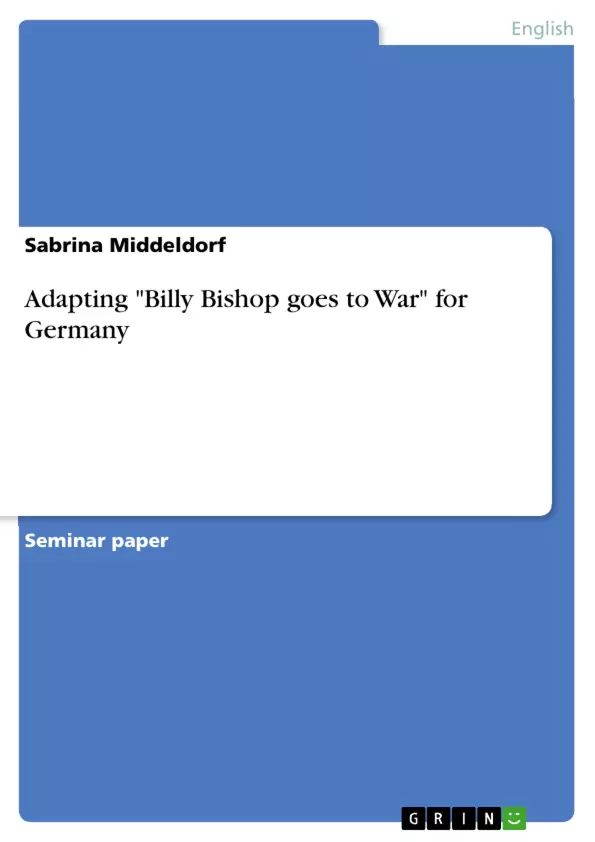I. Introduction – A Canadian play for a German audience
While talking about the play “Billy Bishop goes to war” by John Gray and Eric Peterson that was written in 1976, different points of view play a decisive role. The play deals with a Canadian boy who joins the military because of a lack of possibilities. The action begins in Canada in 1914. That means it is the time of World War I and Canadian forces fight as a part of the Empire against the enemy, namely Germany. The play describes Billy Bishop’s rise from a Canadian boy to a national hero as a fighter ace. Consequently there are different attitudes towards the play, for instance if you are an opponent of war or an advocate of it. Furthermore there is the question of age: if you have fought in a war and have seen how friends die or if you are a young man who is full of bravery, strength and patriotism, you have a different attitude towards such a play. But above all there is the question of nationality. As the play is of Canadian origin and originally played for Canadians, the question is meaningless. But on the one hand the fact that the play received great honor and was performed on Broadway and on the other hand the existence of a German film version opens a completely new kind of adapting the play for Germany.
In the film version there are German actors that play Billy and the piano player and the text is German, too. What these facts mean and how film and play are adapted for Germany is analyzed in the following term paper. Concerning that there is not any kind of secondary literature about this topic that can be accessed by a German Library, the analysis is based upon my own results of analyzing play and film as well as studying the preface of the drama.
The version of the play is the one in the Jerry Wasserman anthology “Modern Canadian Plays” published by Talonbooks, Vancouver and the film version is the one directed by Peter Meincke and Norman McCandlish of the year 1984/1985.
II.1 Summary
The Canadian play “Billy Bishop goes to war” by John Gray and Eric Peterson deals with a young Canadian from Owen Sound, Ontario who becomes a flying-ace and a hero. The play takes place in the year 1914, which means the time of World War I, where recruits from the British colonies were drafted to support the British Empire against the Germans, or as they call it, the Huns. At the age of twenty Billy enters the Royal Military College (R.M.C.) because of a lack of opportunities and the qualification of
Inhaltsverzeichnis (Table of Contents)
- I. Introduction - A Canadian play for a German audience
- II.
- II.1 Summary
- II.2 Formal structure
- II.2.1 Importance of a two-man show
- II.2.2 Importance of the letters
- II.2.3 Importance of the songs
- II.3 What is a Hun?
- II.4 Role of the Hun in the play
- III. Transforming the role of the Hun into a German play
- Conclusion - Adapting an anti-German film for Germany
- Bibliography
Zielsetzung und Themenschwerpunkte (Objectives and Key Themes)
This term paper aims to analyze how the Canadian play "Billy Bishop goes to war" was adapted for a German audience, specifically exploring the film version. By examining the play's structure, characters, and themes, the paper explores how the play's anti-German sentiment was translated into a German context. The analysis draws on the author's own interpretation of the play and film, given the lack of secondary literature on the subject. Key themes explored include:- The portrayal of war and its impact on individuals
- The complexities of national identity and the perception of the "enemy"
- The role of heroism and the celebration of war in the context of a two-man show
- The adaptation of cultural and historical references for a different audience
- The influence of the play's original context on its interpretation in a German setting
Zusammenfassung der Kapitel (Chapter Summaries)
The first chapter, “Introduction – A Canadian play for a German audience,” establishes the play’s context, highlighting its Canadian origins and its anti-German sentiment. The chapter explores the potential challenges and opportunities of adapting the play for a German audience, considering the perspectives of different viewers based on their experiences and nationalities. The author emphasizes the scarcity of secondary literature on the subject, leading to an analysis based on their own interpretation of the play and film. The second chapter, “Summary,” provides a detailed synopsis of the play’s narrative. It follows Billy Bishop, a Canadian young man who joins the military during World War I. The chapter describes his journey from a reluctant soldier to a fighter ace, emphasizing his encounters with war’s harsh realities, his relationships with other characters, and the events that shape his transformation. The third chapter, “Formal structure,” delves into the unique structure of the play. It highlights the two-man show format, with Billy Bishop embodying multiple roles, and the importance of the songs and letters that contribute to the play’s narrative and emotional impact.
Schlüsselwörter (Keywords)
The key terms and concepts explored in this paper include: "Billy Bishop goes to war," Canadian drama, World War I, anti-German sentiment, adaptation, film version, national identity, heroism, two-man show, and cultural translation.- Quote paper
- Sabrina Middeldorf (Author), 2007, Adapting "Billy Bishop goes to War" for Germany, Munich, GRIN Verlag, https://www.grin.com/document/150208



